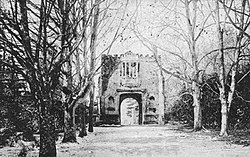Stanley Abbey
| Stanley Cistercian Abbey | |
|---|---|

|
|
| location |
|
| Coordinates: | 51 ° 26 '55 " N , 2 ° 4' 0" W |
| Serial number according to Janauschek |
319 |
| Patronage | St. Mary |
| founding year | 1151 |
| Year of dissolution / annulment |
1536 |
| Mother monastery | Quarr Abbey |
| Primary Abbey | Clairvaux Monastery |
|
Daughter monasteries |
Duiske Abbey (1204) |
Stanley Abbey (Stanlegia imperiatricis) is a former Cistercian abbey in England . The monastery was in Stanley, Wiltshire, on the south side of the Marden Valley in Pewsham Forest, about 2 km south-southwest of Loxwell and 1 km north of the road from Calne to Chippenham .
history
In 1151 the Empress Mathilde and her chamberlain Drogo donated the monks of Quarr Abbey in Loxham in the Pewsham Forest west of the road from Chippenham to Devizes a site for the establishment of a daughter monastery. The monastery was occupied by English monks from the start. Several other foundations soon followed, including a. by Hugh de Plugenet and King Henry II , some of which had to be sold in 1363 in order to be able to settle debts. The monastery was initially referred to as St. Mary of Drownfont (or Downfront). In 1154 it was moved to Stanley, where the water from the first location was directed. As a daughter monastery of Quarr, Stanley Abbey belonged to the Filiation of Clairvaux Primary Abbey via Savigny Monastery . It built a daughter monastery ( Duiske Abbey , also Graiguenamanagh Abbey) in Ireland around 1204 . The abbot Stephen of Lexinton acted to resolve the Mellifont conspiracy in 1228 . At the beginning of the 13th century, part of the crown jewels were kept in Stanley. After 1200, the monastery buildings erected immediately after the move to Stanley (with the exception of the west wing) were renewed, and the new building was occupied in 1247. The new church was consecrated in 1266 after the old one was destroyed in a fire in 1212. The monastery had several grangia, which were initially run by Konversen, but later by farmers. The monastery was raided and looted by rebels during the Despenser War in 1321 . In the Valor Ecclesiasticus , the annual income was estimated at £ 222. The last abbot before the dissolution was Thomas Calne. When it was dissolved, the monastery had nine monks and one novice. In February 1536 the monastery with the smaller monasteries was withdrawn from the crown. The plant was acquired by Sir Edward Baynton.
Plant and buildings
After the dissolution of the monastery, the complex was soon completely demolished. There are no remains above the ground. In 1860 a railway line (now decommissioned) was laid through the monastery. Excavations in 1909 revealed the plan of the monastery complex: three-aisled church in the shape of a Latin cross, transept with two side chapels on each of the east sides, three-aisled rectangular choir. The enclosure was to the north (left) of the church. The Konversenbau in the west was separated from the cloister by a monastery lane. The chapter house had three aisles with six bays. Floor tiles were also exposed, but they have now disappeared.
literature
- Anthony New: A guide to the Abbeys of England and Wales. Constable & Company, London 1985, ISBN 0-09-463520-X , pp. 358 f., With a sketch of the location.
- Houses of Cistercian monks: The abbey of Stanley. In: DA Crowley (Ed.): A History of the County of Wiltshire. Volume 3. Boydell & Brewer, Woodbridge et al. 1989, ISBN 0-7129-1048-4 , pp. 269-275 ( The Victoria History of the Counties of England ), online , with incomplete list of abbots.